Essential Piano Chord Progressions for Pop Music Beginners
Category: Music Theory
Discover the Foundations of Piano Pop Chord Progressions
If you're a beginner pianist or a music enthusiast passionate about learning pop music, you've landed in the right place. Mastering piano chord progressions can seem overwhelming at first — you might be wondering which chords fit together, how they create that catchy pop sound, or how to apply them practically during playing. Maybe you've tried tutorials that get too technical or too vague, leaving you stuck and frustrated.
This guide is tailored just for you: clear, practical, and focused on popular piano chord progressions common in hit pop songs. We'll break down the theory into digestible chunks, illuminate why certain progressions work so well, and walk you through easy-to-follow examples you can start playing right away. Unlike dense music theory texts, this post bridges the gap between understanding and actual application with a special eye on keys you’ll find on the piano.
By the end, you’ll feel confident identifying, playing, and even creating your own pop chord progressions on piano. Whether you want to accompany your favorite songs or write new ones, this beginner-friendly tutorial sets the foundation for your pop piano journey clearly and simply. Keep reading and unlock the secret behind the catchy chords that drive pop music forward.
- Discover the Foundations of Piano Pop Chord Progressions
- Understanding Basic Music Theory Concepts: Notes, Intervals, and Triads
- What Are Chord Progressions and Why They Matter in Pop Music
- Common Pop Chord Progressions to Know (I–V–vi–IV and Variations)
- How to Construct Major and Minor Chords on Piano for Pop Progressions
- Using Seventh and Suspended Chords to Add Flavor in Pop Music
- Tips for Transitioning Smoothly Between Chords on Piano
- Playing Pop Progressions in Different Keys and Using a Capo Equivalent on Piano
- Incorporating Rhythm and Timing: Basic Patterns to Accompany Chord Progressions
- Examples of Popular Pop Songs Using These Progressions on Piano
- Practice Exercises and Next Steps for Developing Your Pop Piano Skills
Understanding Basic Music Theory Concepts: Notes, Intervals, and Triads
Before diving into piano chord progressions, it's essential to grasp a few fundamental music theory concepts that serve as the building blocks for any chord or harmony — especially in pop music. This section will focus on the piano keyboard layout, notes, intervals, and triads, helping you visualize and understand how chords take shape on the piano.
Notes and the Piano Keyboard Layout
The piano is organized into repeating sets of 12 notes: 7 white keys and 5 black keys, spanning multiple octaves. Each white key is named after the first seven letters of the alphabet: A, B, C, D, E, F, G. Black keys represent sharps (#) and flats (b), which are notes in between the white keys. Recognizing this pattern helps you quickly identify notes and locate chords.
Intervals: The Distance Between Notes
An interval is the distance between two notes, measured in steps. On the piano, this distance can be understood in half steps (one key to the very next key, including black keys) or whole steps (two half steps). Intervals form the foundation of chords and melodies. For example, the interval between C and E is a major third, a core component of many pop chords.
Triads: Building Blocks of Chords
A triad is a three-note chord built from stacking intervals of thirds. The most basic triads are:
- Major triad – Root + Major third + Perfect fifth (e.g., C–E–G)
- Minor triad – Root + Minor third + Perfect fifth (e.g., A–C–E)
- Diminished triad – Root + Minor third + Diminished fifth (e.g., B–D–F)
Understanding how these triads are constructed on the piano will empower you to form and recognize the chords that are often found in pop music. Once you're comfortable with notes, intervals, and triads, you’ll be well-equipped to explore popular chord progressions and apply them in your playing.
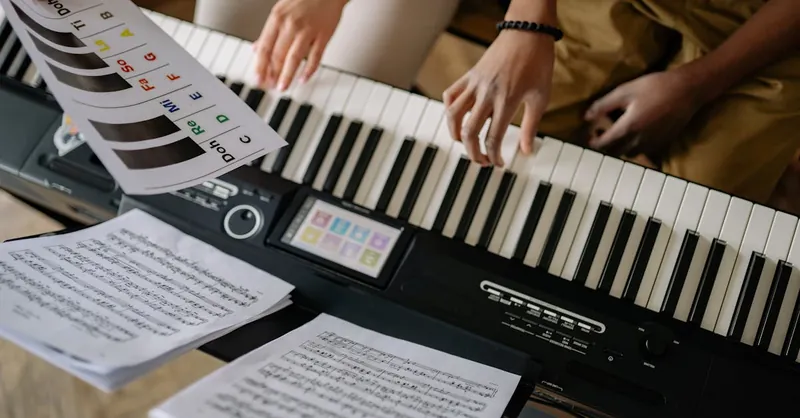
Image courtesy of Yan Krukau
What Are Chord Progressions and Why They Matter in Pop Music
At its core, a chord progression is simply a series of chords played in a sequence. These sequences create the harmonic backbone of a song, guiding the mood, tension, and resolution that listeners feel as the music unfolds. In pop music, chord progressions are particularly crucial because they shape the song’s emotional appeal and catchiness — making hooks memorable and verses compelling.
Why do chord progressions matter so much in pop? Here are the key reasons:
- Establishing Song Structure: Most pop songs follow familiar forms (like verse-chorus-bridge), and chord progressions define each section’s harmonic flow, helping to differentiate between them while maintaining musical coherence.
- Evoking Emotions: Different progressions can create feelings of happiness, sadness, excitement, or nostalgia. For example, a major progression often sounds bright and uplifting, while a minor progression introduces a more introspective or moody vibe.
- Creating Catchy Hooks: Many hit pop songs rely on simple yet effective chord progressions that repeat in cycles, making the song easy to remember and sing along to.
- Supporting Melody and Lyrics: Chord progressions provide the underlying harmony for the vocal melody and lyrics, reinforcing the song’s message and enhancing its impact.
Understanding chord progressions empowers you to analyze your favorite pop songs, replicate their charm on the piano, and eventually craft your own original progressions that resonate. As you continue, we’ll explore some of the most popular and versatile progressions used in classic and contemporary pop hits, making your playing both enjoyable and authentic.
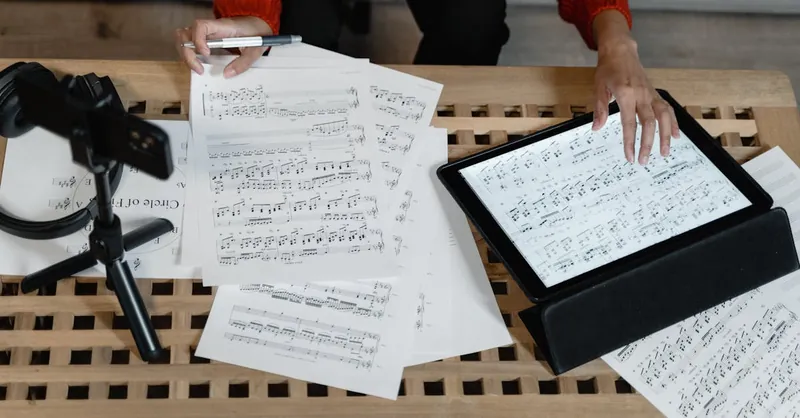
Image courtesy of Tima Miroshnichenko
Common Pop Chord Progressions to Know (I–V–vi–IV and Variations)
One of the most iconic and widely used chord progressions in pop music is the I–V–vi–IV progression. This sequence forms the harmonic foundation for countless hit songs, making it essential for any beginner pianist to understand and master. In the key of C major, these chords correspond to:
- I (C major): C - E - G
- V (G major): G - B - D
- vi (A minor): A - C - E
- IV (F major): F - A - C
This progression creates a pleasing emotional journey—starting with a strong tonic (I), moving to the dominant (V) which builds tension, followed by the relative minor (vi) introducing warmth or melancholy, and resolving on the subdominant (IV) for a satisfying loop back to the tonic. The I–V–vi–IV sequence is beloved for its catchy, uplifting, yet emotionally nuanced sound.
Variations and How to Play Them on Piano
While the I–V–vi–IV progression is foundational, pop music often uses variations of this progression to add interest and freshness. Some common alternatives include:
- vi–IV–I–V: Starts on the minor chord, shifting the emotional tone from the outset (e.g., “Apologize” by OneRepublic)
- I–vi–IV–V: A classic doo-wop progression used in many older pop tunes
- I–V–IV–V: Adding movement by alternating between dominant and subdominant chords
Playing the I–V–vi–IV Progression on Piano
To try this progression in C major, play the triads in root position or experiment with inversions to create smoother voice leading:
| Chord | Notes (Root Position) | Suggested Fingering (Right Hand) |
|---|---|---|
| C | C - E - G | 1 (thumb) - 3 (middle) - 5 (pinky) |
| G | G - B - D | 1 - 3 - 5 |
| Am | A - C - E | 1 - 2 - 5 |
| F | F - A - C | 1 - 3 - 5 |
Practicing this progression in a loop will help internalize the feel and sound that powers many pop hits. Once comfortable, try playing along with well-known songs using this progression or experiment by changing the key to match your vocal range or preference.
By mastering the I–V–vi–IV and its variations, you unlock a versatile harmonic toolkit that can accompany sing-alongs, songwriting, or simply enhance your understanding of why pop music sounds so captivating on piano.
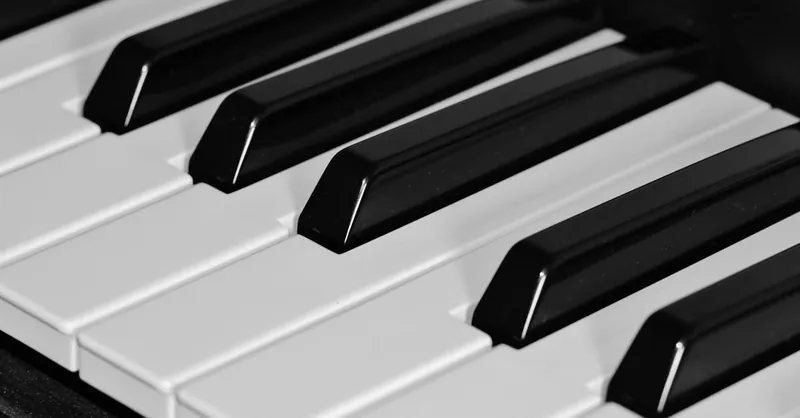
Image courtesy of Pixabay
How to Construct Major and Minor Chords on Piano for Pop Progressions
Understanding how to form major and minor chords on the piano is a crucial skill for playing and creating pop chord progressions. These two types of chords form the backbone of most pop music, giving songs their distinctive moods—major chords sound bright and happy, while minor chords often bring a more emotional or introspective vibe.
Constructing Major Chords
A major chord (or major triad) consists of three notes:
- Root: The starting note (gives the chord its name)
- Major third: Four half steps (or semitones) above the root
- Perfect fifth: Seven half steps above the root
Example: C major chord
- Root: C
- Major third: E (4 half steps above C)
- Perfect fifth: G (7 half steps above C)
To play a C major chord on the piano, simply press the C, E, and G notes simultaneously. The major third interval between C and E gives the chord its bright tonality, essential for many upbeat pop songs.
Constructing Minor Chords
A minor chord (or minor triad) is very similar but differs in the middle note:
- Root: The starting note
- Minor third: Three half steps above the root (one half step lower than the major third)
- Perfect fifth: Seven half steps above the root
Example: A minor chord
- Root: A
- Minor third: C (3 half steps above A)
- Perfect fifth: E (7 half steps above A)
Playing A, C, and E together gives you the minor chord’s characteristic mellow and slightly somber sound. This chord is extremely common in pop ballads and emotional bridge sections.
Recognizing and Applying Major and Minor Chords in Pop Progressions
In pop music, you’ll mostly encounter major and minor chords played within the key’s scale. For example, if you’re in the key of C major, the I, IV, and V chords are major, while the ii, iii, and vi chords are minor. Using your knowledge of chord construction, you can quickly build these chords on the piano and understand their emotional role within a progression.
To practice:
- Start by identifying the root note of the chord you want to play.
- Count up the appropriate number of half steps to find the major or minor third.
- Count up seven half steps from the root to find the perfect fifth.
- Play all three notes together to hear how the chord sounds.
Mastering these two fundamental chord types will dramatically expand your ability to play and create catchy pop chord progressions on piano, helping you bring songs to life with the right emotional tone. Plus, once you feel comfortable constructing these chords, experimenting with chord inversions and voicings will add even richer textures to your playing.
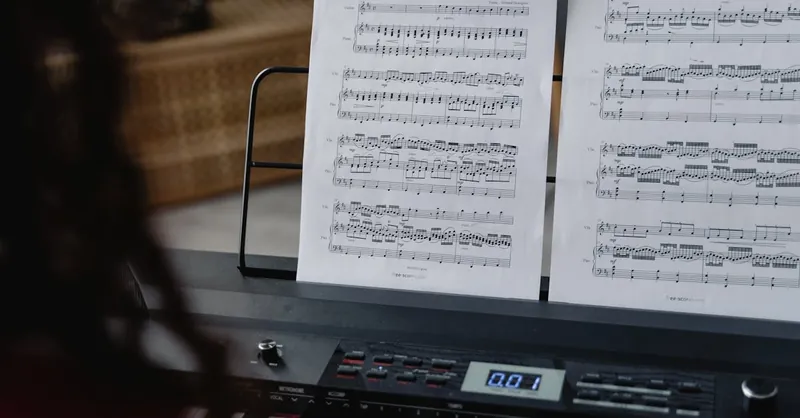
Image courtesy of Tima Miroshnichenko
Using Seventh and Suspended Chords to Add Flavor in Pop Music
While major and minor chords form the core of most pop music progressions, introducing seventh chords and suspended chords (sus chords) can instantly add emotional depth, color, and musical interest to your piano playing. These simple chord extensions go beyond the basic triads by incorporating additional notes that enhance the harmonic texture, making your progressions sound more polished and expressive — a hallmark of contemporary pop music.
What Are Seventh Chords and How Do They Affect Pop Music’s Emotional Tone?
A seventh chord is created by adding a seventh interval (either major or minor) on top of a basic triad. The addition of this note generates a richer sound and a more nuanced emotional vibe. In pop music, the two most common types are:
- Major seventh chords (e.g., Cmaj7): Root + Major third + Perfect fifth + Major seventh
- Sound bright, jazzy, and dreamy, often evoking a smooth, sophisticated atmosphere.
- Dominant seventh chords (e.g., G7): Root + Major third + Perfect fifth + Minor seventh
- Inject a bit of tension and expectation, pushing the progression forward in a playful or soulful way.
Seventh chords soften the starkness of simple triads and add an emotional “warmth” that many pop ballads and upbeat songs use to create memorable harmonic moments.
Exploring Suspended Chords (Sus2 and Sus4) for Dynamic Tension
Suspended chords replace the third of a triad with either the second or fourth scale degree, resulting in a sound that feels open, unresolved, or suspenseful. The two primary types you’ll encounter are:
- Sus2 Chord (Root + Major second + Perfect fifth): Creates a light, airy feeling, ideal for transitions or lifting the mood.
- Sus4 Chord (Root + Perfect fourth + Perfect fifth): Produces a sense of tension that begs to be resolved, making it perfect for building anticipation before returning to a major or minor chord.
In pop music, sus chords are frequently used to add movement and emotional nuance without changing the underlying harmonic structure. Their unresolved nature keeps listeners engaged and adds flavor to otherwise simple progressions.
How to Play Seventh and Suspended Chords on Piano
To experiment with these chords, start with a basic triad and then:
- For seventh chords, add the appropriate seventh note above the root (10 half steps above for major seventh, 9 half steps above for dominant seventh).
- For sus chords, remove the third and replace it with either the second (sus2) or fourth (sus4) note relative to the root.
For example, in the key of C:
| Chord | Notes | Description |
|---|---|---|
| Cmaj7 | C - E - G - B | Adds a dreamy, jazzy feel |
| G7 | G - B - D - F | Introduces tension, leads forward |
| Csus2 | C - D - G | Light, open sound |
| Csus4 | C - F - G | Tense, awaiting resolution |
Incorporating seventh and suspended chords into your pop piano progressions will elevate your playing by adding expressive harmonic colors that resonate with the emotional subtleties found in many popular hits. Experimenting with these chords not only enriches your sound but also boosts your creativity as you explore more complex and engaging chord sequences.

Image courtesy of RDNE Stock project
Tips for Transitioning Smoothly Between Chords on Piano
One of the biggest challenges beginners face when playing pop chord progressions on piano is making smooth, fluid transitions between chords. Choppy or delayed chord changes can interrupt the groove and take away from the song’s natural flow. However, with a few practical tips and smart finger positioning techniques, you can switch chords effortlessly and sound more polished.
Practical Advice for Seamless Chord Changes
- Plan Your Finger Placement in Advance: Before you switch to the next chord, visualize which fingers will press which notes. This mental preparation helps avoid unnecessary hand movements or awkward stretching.
- Use Common Fingers for Shared Notes: When two consecutive chords share one or more notes, try to keep those fingers anchored on those keys. This reduces finger travel and increases speed.
- Practice Slow, Repetitive Changes: Start by changing between two chords slowly, focusing on finger positions and smooth release and press of keys. Gradually increase your speed as your muscle memory improves.
- Keep Your Fingers Curved and Relaxed: Maintaining a natural curved shape with your fingers allows for quicker and cleaner transitions, preventing tension or stiffness that can slow you down.
Finger Positioning Tips to Enhance Fluidity
- Use Inversions to Minimize Movement: Playing chords in different inversions (rearranging the order of notes) can bring chord tones physically closer together on the keyboard. This technique makes hand movements smaller and transitions faster.
- Assign Specific Fingers for Each Note: Common fingerings for triads are thumb (1) on the root or lowest note, middle finger (3) or ring finger (4) on the middle notes, and pinky (5) on the highest note. Sticking to consistent fingerings builds reliable patterns.
- Anticipate the Next Chord: Move your hand slightly toward the next chord’s position before completing the current chord. This subtle pre-positioning saves time and smooths the transition.
Mastering these strategies not only improves your technical skills but also boosts confidence, allowing you to focus on expression and rhythm while playing popular chord progressions. Smooth chord changes are essential for capturing the catchy and polished feel that defines pop piano music, making your overall playing more enjoyable and professional.
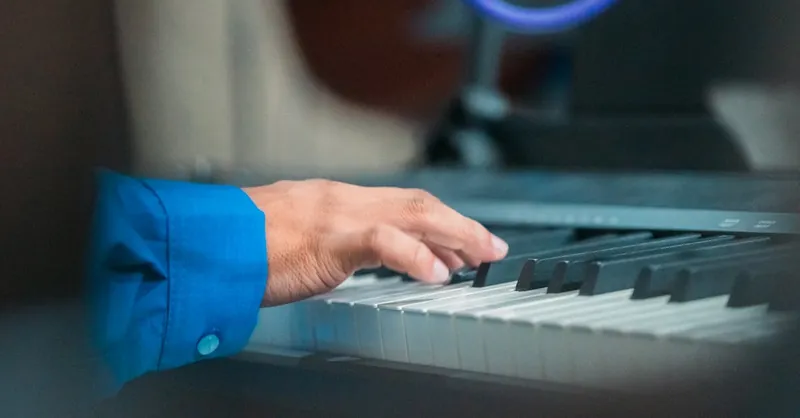
Image courtesy of Jeric Turga
Playing Pop Progressions in Different Keys and Using a Capo Equivalent on Piano
A key skill for any aspiring pianist is the ability to transpose pop chord progressions to different keys effortlessly. Transposing means shifting all the chords of a progression up or down by the same interval to match a desired vocal range, collaborate with other musicians, or simply add variety to your playing. Unlike guitar players who often use a capo to change keys without learning new chord shapes, pianists can use a similar conceptual approach by understanding how to move chord shapes around the keyboard.
How to Transpose Common Pop Progressions Easily
To transpose a chord progression like the famous I–V–vi–IV to another key, follow these simple steps:
- Identify the original key and chords. For example, in C major:
I = C, V = G, vi = Am, IV = F - Choose your target key. Say you want to transpose to G major.
- Find the scale degrees in the new key. In G major, the chords become:
I = G, V = D, vi = Em, IV = C - Play the same chord qualities (major, minor) on the new root notes.
This method uses the idea of scale degrees (I, V, vi, IV) as a roadmap rather than memorizing fixed chord shapes, making your progressing flexible and adaptable.
Using a "Capo Equivalent" on Piano: Shifting Progressions While Preserving Shapes
While the piano doesn’t have a physical capo like the guitar, you can think of transposing as shifting your hand position up or down the keyboard while maintaining the chord shapes and fingerings. This is especially effective once you’re comfortable with the chord formations, as you simply move everything by the same number of keys (half steps):
- To transpose up by 2 half steps (a whole step), move every chord up two keys.
- To transpose down by 1 half step, move every chord down one key.
This approach helps pianist beginners avoid confusion over new fingerings while building muscle memory of chord shapes and intervals. Over time, as you become more familiar with the piano’s layout, transposing by ear and adapting to any key will feel natural and intuitive.
Why Transposing and Key Flexibility Are Crucial for Pop Piano
- Versatility: Being able to switch keys allows you to play with singers of various ranges or accompany different instruments.
- Creative Freedom: Transposing encourages experimentation with new sounds and moods that specific keys offer.
- Improved Music Theory Understanding: Practicing transpositions reinforces your grasp of intervals, scales, and chord relationships.
By mastering the art of transposing pop chord progressions and using the piano’s "capo equivalent," you’ll significantly expand your playing versatility and confidence, ultimately enhancing your ability to perform and write dynamic pop music pieces.
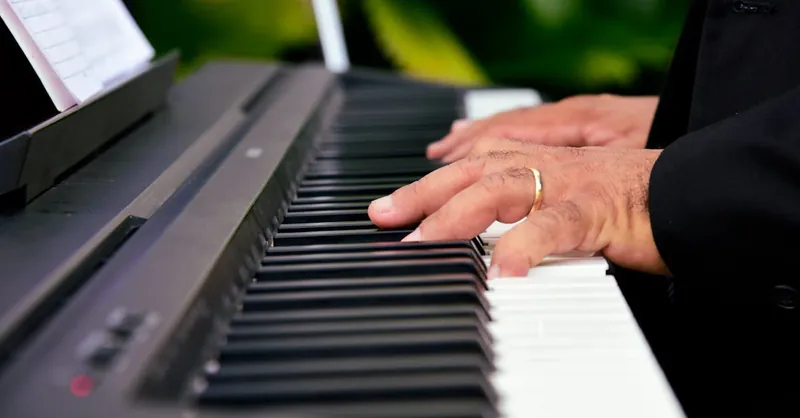
Image courtesy of Joel Uribe
Incorporating Rhythm and Timing: Basic Patterns to Accompany Chord Progressions
Mastering rhythm and timing is just as important as knowing the chords themselves when playing pop piano. The way you play chord progressions, through varied rhythmic patterns, directly influences the groove and feel of a song. Even simple chord sequences can sound dynamic and engaging with the right rhythmic accompaniment, turning static harmony into lively, catchy music.
Understanding Basic Rhythmic Patterns for Pop Piano
In pop music, most piano parts use straightforward, steady rhythms that complement the song’s groove without overpowering the vocals or other instruments. Here are some basic rhythmic patterns you can apply when accompanying chord progressions:
- Quarter Note Strumming: Play the chord on every beat (1, 2, 3, 4). This pattern is simple and solid, providing a consistent pulse ideal for beginners.
- Half Note Holds: Play the chord on beats 1 and 3 or 2 and 4, allowing more space between changes. This creates a relaxed, spacious feel common in ballads.
- Syncopated Rhythms: Accent off-beats (the “ands” between numbers) to add bounce and groove. For example, playing chords on 1 and the “&” of 2 gives a subtle rhythmic lift.
- Arpeggiated Patterns: Instead of pressing all chord notes at once, play them sequentially in an order—up or down. This adds a melodic flow and highlights each chord tone.
- Rhythmic Stabs: Short, percussive chords played on specific beats or rests create rhythmic interest and tension, often used in upbeat pop songs.
Why Rhythm Complements Chord Progressions in Pop
Chord progressions provide the harmonic foundation, but rhythm shapes the energy and drive of the music. By combining solid chord structures with complementary rhythmic patterns, you:
- Create groove and momentum that keeps listeners engaged
- Enhance emotional expression by controlling song pacing and tension
- Make progressions feel less predictable and more lively
- Support other rhythmic elements like vocals, drums, or bass, ensuring cohesive arrangements
As you practice pop piano, experiment with these rhythmic ideas alongside your chord progressions. Start slowly, focus on keeping time with a metronome, and try mixing different patterns within the same progression to see how they change the song’s vibe. Developing a strong rhythmic sense will not only improve your piano playing but also deepen your overall musicality in pop music.
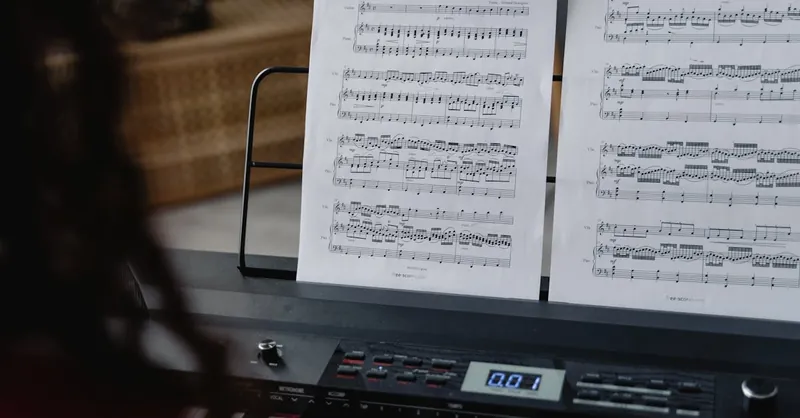
Image courtesy of Tima Miroshnichenko
Examples of Popular Pop Songs Using These Progressions on Piano
Now that you’ve learned the basics of pop piano chord progressions, it’s time to see how these progressions come alive in some of the most famous songs. Analyzing real-world examples helps you understand how songwriters use familiar chord sequences to craft memorable melodies, emotional moods, and catchy hooks. Below, we break down key songs featuring the classic I–V–vi–IV progression and its popular variations, showing you exactly how to play them on piano.
1. “Let It Be” by The Beatles (I–V–vi–IV Progression in C Major)
One of the timeless examples of the I–V–vi–IV progression is The Beatles’ “Let It Be.” The chords cycle through:
- C major (I)
- G major (V)
- A minor (vi)
- F major (IV)
Playing these chords in this sequence on piano creates the song’s iconic, uplifting feeling. The steady harmonic rhythm supports the emotional vocal melody, making it a perfect beginner-friendly piece to practice this progression.
2. “Apologize” by OneRepublic (vi–IV–I–V Progression)
This deeply emotional hit uses a variation starting on the relative minor:
- A minor (vi)
- F major (IV)
- C major (I)
- G major (V)
This sequence shifts the emotional tone to a more reflective and poignant mood right from the start, demonstrating how subtle changes in progression order affect the song’s atmosphere. On piano, playing these chords with smooth transitions highlights the song’s melancholic yet hopeful vibe.
3. “Can’t Stop the Feeling!” by Justin Timberlake (I–IV–V Progression)
While slightly simpler, this upbeat pop anthem uses a bright and energetic progression mostly cycling through:
- C major (I)
- F major (IV)
- G major (V)
This classic three-chord formula creates a joyful and danceable groove perfect for beginner pianists focusing on rhythmic precision while maintaining harmonic interest.
How to Use These Examples in Your Practice
- Play Along: Find the chords for these songs and play along with the original recordings or backing tracks to internalize the feel and timing.
- Experiment with Voicings: Try playing root position chords as well as inversions to mimic the song’s smoothness.
- Create Your Own Variations: Use the progression structures as templates to write your own melodies or accompaniments.
By studying these popular pop songs’ chord progressions on piano, you’ll build practical skills and gain inspiration for your own musical journey. Recognizing these progressions in songs enhances your ear training and helps bridge theoretical knowledge to real-world playing.
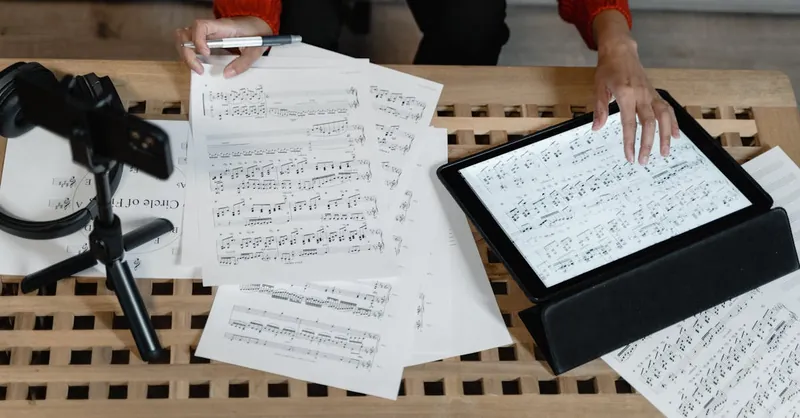
Image courtesy of Tima Miroshnichenko
Practice Exercises and Next Steps for Developing Your Pop Piano Skills
To truly master pop piano chord progressions, consistent practice and gradual skill-building are essential. Incorporating targeted exercises into your routine will reinforce your understanding of chord shapes, transitions, and rhythmic patterns, while keeping your motivation high as you hear noticeable progress.
Practical Exercises to Strengthen Your Pop Piano Playing
- Loop the I–V–vi–IV Progression: Spend 5-10 minutes daily playing this foundational progression in different keys. Focus on smooth transitions and consistent rhythm. Gradually experiment with chord inversions and adding seventh or suspended chords to increase harmonic richness.
- Transpose Simple Progressions: Choose a familiar chord progression and transpose it up or down by one or two half steps. This will improve your ear training and help solidify your understanding of key relationships.
- Rhythmic Variation Drills: Practice playing the same chord progression using different rhythm patterns, such as quarter notes, syncopation, and arpeggios. Use a metronome to maintain steady timing and develop groove.
- Ear Training with Pop Songs: Listen actively to your favorite pop songs identified in previous sections. Try to play along by ear, focusing on chord changes and rhythmic feel. This bridges theory with real-world application.
- Create Your Own Progressions: Apply your knowledge by composing short chord sequences combining major, minor, seventh, and suspended chords. Experiment with chord order and rhythm to find catchy patterns that inspire you.
Recommended Resources for Continued Learning and Inspiration
- Online Piano Tutorials: Websites like JustinGuitar, Pianote, and Flowkey offer structured lessons on pop piano chords and progressions tailored to beginners.
- Mobile Apps: Apps such as Yousician and Simply Piano provide interactive practice with instant feedback to sharpen your skills.
- YouTube Channels: Channels like Pianist HD and Rick Beato analyze pop chord progressions and demonstrate playing techniques that deepen your musical understanding.
- Ear Training Platforms: Tools like Functional Ear Trainer and Tenuto help develop your ability to recognize chord qualities and progressions by ear.
- Song Sheets and Lead Sheets: Exploring simplified sheet music or lead sheets of popular pop songs lets you practice real chord progressions while improving sight-reading.
Maintaining a regular practice schedule integrating these exercises and resources will keep your motivation high and accelerate your growth as a pop pianist. Remember, the journey from learning basic chord progressions to confidently improvising and composing is rewarding and achievable—one chord at a time. Keep exploring, playing, and enjoying the vibrant world of pop piano music!

Image courtesy of cottonbro studio
